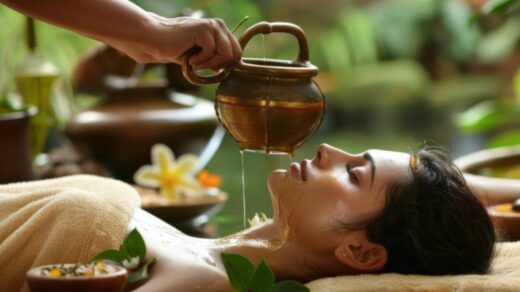Ayurveda and the Chakras: Balancing Body and Soul
In the vast landscape of holistic health, Ayurveda and the concept of Chakras stand as pillars of ancient wisdom. Rooted in the rich traditions of India, both Ayurveda and Chakras offer profound insights into achieving harmony in the body, mind, and spirit. 
Ayurveda, with its emphasis on balancing the doshas (vital energies), and the Chakras, with their focus on energy centers, provide complementary approaches to well-being. By integrating these systems, one can better understand how to align physical health with energetic balance.
But how exactly do these two powerful systems intersect, and what can they teach us about living a balanced life? Let’s delve into the intricate relationship between Ayurveda and the Chakras, exploring how they work together to promote overall harmony and vitality.
Introduction to Ayurveda and Chakras
1. Overview of Ayurveda
Ayurveda, often referred to as the “science of life,” is a 5,000-year-old system of natural healing that originated in India. It is a comprehensive approach to health and wellness, emphasizing balance in the body’s energies—Vata, Pitta, and Kapha—through diet, lifestyle, and natural therapies.
Ayurveda doesn’t just treat symptoms; it addresses the root causes of imbalances to restore health and prevent disease.
2. Introduction to Chakras
Chakras are energy centers within the human body, according to ancient Indian traditions. The word “Chakra” means “wheel” in Sanskrit, signifying the spinning energy that each Chakra represents.
There are seven major Chakras, each corresponding to specific physical, emotional, and spiritual aspects of our being. These Chakras are aligned along the spine, from the base to the crown of the head.
3. Connection between Ayurveda and Chakras
Ayurveda and the Chakras are deeply interconnected. While Ayurveda focuses on balancing the body’s physical and doshic energies, Chakras represent the energetic aspect of our being.
When Chakras are balanced, prana (life force) flows freely, promoting physical health, emotional well-being, and spiritual growth. Ayurveda provides the tools to maintain this balance through diet, lifestyle, and specific therapies.
The Concept of Chakras in Ayurveda
1. Understanding the Chakra System
The Chakra system is a map of energy centers in the body, each with its unique characteristics and functions. These energy centers are not physical organs but subtle energy fields that influence our physical, mental, and spiritual states.
The seven major Chakras are the Root, Sacral, Solar Plexus, Heart, Throat, Third Eye, and Crown Chakras.
2. The Role of Prana (Life Force)
Prana, or life force, is the vital energy that flows through our bodies, keeping us alive and vibrant. It is the link between our physical and energetic bodies.
Prana circulates through the Chakras, energizing and nourishing them. When prana flows freely, the Chakras are balanced, leading to optimal health and well-being.
3. How Chakras Influence Physical and Mental Health
Each Chakra corresponds to specific physical organs and emotional states. For example, the Heart Chakra is associated with love and compassion, and it influences the heart, lungs, and circulatory system.
An imbalance in any Chakra can manifest as physical ailments or emotional disturbances. Balancing the Chakras through Ayurveda helps in healing these issues at their root.
7 Chakras of Ayurveda
1. Muladhara (Root Chakra)
- Location and Element: Located at the base of the spine, the Root Chakra is associated with the earth element.
- Associated Organs and Functions: It governs the legs, feet, and elimination organs. The Root Chakra is linked to our sense of security, stability, and survival.
2. Svadhisthana (Sacral Chakra)
- Location and Element: Situated just below the navel, the Sacral Chakra is associated with the water element.
- Associated Organs and Functions: It influences the reproductive organs, kidneys, and bladder. This Chakra governs creativity, sensuality, and emotions.
3. Manipura (Solar Plexus Chakra)
- Location and Element: Located in the upper abdomen, the Solar Plexus Chakra is associated with the fire element.
- Associated Organs and Functions: It affects the digestive system, liver, and pancreas. The Solar Plexus Chakra is the center of personal power, confidence, and self-esteem.
4. Anahata (Heart Chakra)
- Location and Element: Situated in the center of the chest, the Heart Chakra is associated with the air element.
- Associated Organs and Functions: It governs the heart, lungs, and circulatory system. The Heart Chakra is linked to love, compassion, and forgiveness.
5. Vishuddha (Throat Chakra)
- Location and Element: Located at the throat, the Throat Chakra is associated with the ether (space) element.
- Associated Organs and Functions: It influences the throat, thyroid, and communication organs. This Chakra governs expression, communication, and truth.
6. Ajna (Third Eye Chakra)
- Location and Element: Situated between the eyebrows, the Third Eye Chakra is associated with the mind.
- Associated Organs and Functions: It affects the eyes, brain, and pineal gland. The Third Eye Chakra is the center of intuition, insight, and spiritual awareness.
7. Sahasrara (Crown Chakra)
- Location and Element: Located at the crown of the head, the Crown Chakra is associated with pure consciousness.
- Associated Organs and Functions: It governs the brain and nervous system. The Crown Chakra is the gateway to spiritual enlightenment and higher consciousness.
Balancing Chakras through Ayurveda
1. Importance of Balancing Chakras
Balanced Chakras ensure that prana flows smoothly through the body, supporting physical health and emotional well-being.
An imbalance in any Chakra can disrupt this flow, leading to physical, mental, and spiritual issues. Therefore, maintaining Chakra balance is crucial for overall health.
2. Ayurvedic Practices for Chakra Balancing
Ayurveda offers various practices to balance the Chakras, including diet, herbs, meditation, and lifestyle changes. These practices help in harmonizing the body’s energies and promoting the free flow of prana.
3. Diet and Herbs for Chakra Healing
Each Chakra can be balanced with specific foods and herbs. For example, root vegetables and proteins are grounding and can help balance the Root Chakra.
Similarly, spices like ginger and turmeric can ignite the Solar Plexus Chakra. Incorporating these dietary elements into your routine can support Chakra’s health.
Ayurvedic Techniques for Chakra Healing
1. Meditation and Pranayama
Meditation is a powerful tool for Chakra healing. By focusing on each Chakra during meditation, you can direct prana to areas that need balance. Pranayama, or breath control, helps in regulating the flow of prana, clearing blockages in the Chakras.
2. Yoga and Asanas
Certain yoga poses, or asanas, are designed to activate and balance specific Chakras. For instance, the Tree Pose is beneficial for grounding and balancing the Root Chakra, while the Camel Pose can open the Heart Chakra.
3. Marma Therapy
Marma therapy involves stimulating specific energy points on the body that correspond to the Chakras. This ancient Ayurvedic technique helps in balancing the Chakras by promoting the free flow of prana.
4. Aromatherapy and Essential Oils
Essential oils are potent tools for Chakra healing. For example, sandalwood can help balance the Crown Chakra, while lavender is soothing for the Third Eye Chakra. Incorporating these oils into your daily routine can enhance Chakra balance.
Signs of Imbalanced Chakras
1. Physical Symptoms
Imbalanced Chakras often manifest as physical symptoms. For example, an imbalanced Root Chakra may cause issues like constipation or fatigue, while an imbalanced Heart Chakra could lead to heart-related ailments.
2. Emotional and Mental Symptoms
Chakra imbalances also affect our emotions and mental state. An overactive Sacral Chakra may lead to emotional instability, while an underactive Throat Chakra could cause communication issues.
3. Chakra-Specific Imbalances
Each Chakra has its unique set of imbalances. Understanding these can help you identify which Chakra needs attention. For example, fear and insecurity are signs of an imbalanced Root Chakra, while lack of focus and confusion may indicate issues with the Third Eye Chakra.
Benefits of Ayurveda and the Chakras
1. Holistic Health Balance:
- Ayurveda: Focuses on balancing the three doshas (Vata, Pitta, and Kapha) through diet, lifestyle, and herbal remedies to achieve overall well-being.
- Chakras: Balancing the chakras ensures that energy flows freely through the body, addressing physical, emotional, and spiritual imbalances.
2. Enhanced Emotional Well-being:
- Ayurveda: Provides personalized approaches to manage stress and emotional disturbances based on individual dosha imbalances.
- Chakras: Helps in understanding and healing emotional blocks by focusing on specific energy centers related to different emotions.
3. Improved Physical Health:
- Ayurveda: Uses diet and herbal treatments to address and prevent health issues, supporting overall physical health and vitality.
- Chakras: Each chakra is linked to specific organs and systems; balancing them can enhance the functioning of these organs and improve overall physical health.
4. Greater Mental Clarity and Focus:
- Ayurveda: Recommends practices like meditation and mindful living to enhance cognitive function and mental clarity.
- Chakras: Focusing on the Third Eye Chakra (Ajna) can boost intuition, insight, and mental focus.
5. Spiritual Growth and Awareness:
- Ayurveda: Encourages practices like meditation and yoga that foster spiritual growth and self-awareness.
- Chakras: The Crown Chakra (Sahasrara) facilitates higher consciousness and spiritual enlightenment.
6. Stress Reduction:
- Ayurveda: Provides tools and techniques to manage stress through lifestyle adjustments, dietary changes, and relaxation practices.
- Chakras: Balancing the Root Chakra (Muladhara) helps in grounding and managing stress, creating a sense of security and stability.
7. Personalized Wellness Plans:
- Ayurveda: Tailors health recommendations based on individual dosha profiles, offering a customized approach to wellness.
- Chakras: Offers specific practices and meditations for each chakra to address unique energy imbalances and promote well-being.
Integrating Ayurveda and the Chakras allows for a comprehensive approach to health that addresses the body, mind, and spirit, promoting overall harmony, balance, and vitality.
Ayurvedic Herbs for Balancing Chakras
1. Muladhara (Root Chakra)
Herbs:
- Ashwagandha (Withania somnifera): Known for its grounding properties, it helps in reducing stress and anxiety, providing a sense of stability.
- Shatavari (Asparagus racemosus): Supports overall vitality and strengthens the body’s resilience, enhancing a feeling of security.
2. Svadhisthana (Sacral Chakra)
Herbs:
- Shankhapushpi (Convolvulus pluricaulis): Aids in emotional balance and enhances creativity, supporting the Sacral Chakra’s role in sensuality and expression.
- Brahmi (Bacopa monnieri): Promotes mental clarity and emotional well-being, fostering creative and emotional balance.
3. Manipura (Solar Plexus Chakra)
Herbs:
- Trikatu (Combination of black pepper, long pepper, and ginger): Stimulates digestive fire and improves metabolism, supporting the Solar Plexus Chakra’s role in personal power and confidence.
- Turmeric (Curcuma longa): Known for its anti-inflammatory properties, it supports digestion and overall vitality.
4. Anahata (Heart Chakra)
Herbs:
- Hawthorn (Crataegus spp.): Supports cardiovascular health and emotional balance, nurturing the Heart Chakra’s association with love and compassion.
- Tulsi (Holy Basil, Ocimum sanctum): Enhances emotional resilience and promotes inner peace, aligning with the Heart Chakra’s qualities.
5. Vishuddha (Throat Chakra)
Herbs:
- Licorice (Glycyrrhiza glabra): Soothes the throat and supports vocal health, aiding in clear expression and communication.
- Gotu Kola (Centella asiatica): Enhances mental clarity and supports effective communication and expression.
6. Ajna (Third Eye Chakra)
Herbs:
- Brahmi (Bacopa monnieri): Enhances cognitive function and intuitive insight, supporting the Third Eye Chakra’s role in intuition and perception.
- Peppermint (Mentha piperita): Stimulates mental clarity and focus, aiding in the development of intuition and insight.
7. Sahasrara (Crown Chakra)
Herbs:
- Ashwagandha (Withania somnifera): Supports overall vitality and spiritual growth, aligning with the Crown Chakra’s focus on higher consciousness.
- Sandalwood (Santalum album): Promotes mental calmness and spiritual connection, supporting the Crown Chakra’s role in enlightenment and unity.
Each herb supports the respective chakra by addressing specific aspects of physical, emotional, and spiritual health, enhancing overall balance and harmony.
Incorporating these herbs into your wellness routine can help align and balance the chakras, promoting holistic well-being.
How to Align Chakras with Ayurvedic Rituals
1. Daily Ayurvedic Rituals for Chakra Alignment
Incorporating daily Ayurvedic rituals such as Abhyanga (oil massage), meditation, and pranayama can help in maintaining Chakra balance. These practices harmonize the body’s energies and promote overall well-being.
2. Chakra-Specific Rituals
Each Chakra can benefit from specific rituals. For instance, grounding practices like walking barefoot on the earth can balance the Root Chakra, while spending time in nature can harmonize the Heart Chakra.
3. Lifestyle Changes for Sustained Chakra Health
Adopting a balanced lifestyle is key to sustained Chakra health. This includes a balanced diet, regular exercise, sufficient rest, and positive relationships. By aligning your lifestyle with Ayurvedic principles, you can ensure that your Chakras remain balanced.
FAQs
1. What is the connection between Ayurveda and Chakras?
Ayurveda and Chakras are both rooted in ancient Indian traditions and are focused on maintaining balance within the body. Ayurveda emphasizes balancing the physical body through diet, lifestyle, and natural therapies, while Chakras represent the energetic centers that influence physical, mental, and spiritual well-being. Together, they provide a holistic approach to health.
2. How do I know if my Chakras are imbalanced?
Chakra imbalances can manifest in various ways. Physically, you might experience issues like digestive problems, fatigue, or headaches. Emotionally, you might feel anxious, depressed, or overly emotional. Specific symptoms can also point to imbalances in particular Chakras, such as throat issues indicating a blocked Throat Chakra.
3. Can diet alone balance my Chakras?
Diet plays a crucial role in balancing Chakras, but it is not the only factor. While consuming specific foods and herbs can help balance certain Chakras, incorporating other Ayurvedic practices such as meditation, yoga, and pranayama is essential for achieving comprehensive Chakra balance.
4. Is it possible to balance all Chakras at once?
Yes, it is possible to balance all Chakras simultaneously through consistent and holistic practices. Regular meditation, pranayama, a balanced diet, and a healthy lifestyle can help keep all Chakras aligned and functioning optimally.
5. What are the long-term benefits of Chakra balancing?
Balancing your Chakras can lead to long-term benefits such as improved physical health, emotional stability, mental clarity, and spiritual growth. Over time, balanced Chakras can help you feel more grounded, peaceful, and connected to your inner self, leading to a more harmonious and fulfilling life.

























